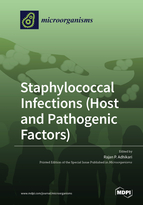Staphylococcal Infections (Host and Pathogenic Factors)
A special issue of Microorganisms (ISSN 2076-2607). This special issue belongs to the section "Molecular Microbiology and Immunology".
Deadline for manuscript submissions: closed (28 February 2021) | Viewed by 47565
Special Issue Editor
Interests: bacterial toxins; host-pathogen interactions; bacterial pathogens; Staphylococcus aureus
Special Issues, Collections and Topics in MDPI journals
Special Issue Information
Dear Colleagues,
Although 30% of the healthy human population is colonized with various Staphylococcus spp., some staphylococcal strains, referred to as opportunistic pathogens, can cause minor to life-threatening diseases. The pathogenicity of these bacteria depends on their virulence factors and the robustness of the regulatory networks expressing these virulence factors. Virulence factors of pathogenic Staphylococcus spp. consist of numerous toxins, enterotoxins (some of which act as superantigens), enzymes, and proteins (cytoplasmic, extracellular, and surface) that are regulated by two-component (TC) and quorum-sensing (QS) regulatory networks. For example, based on their homology with quorum-sensing molecules/components, one Staphylococcus aureus species can alter the toxin/surface protein production of another S. aureus species either synergistically or antagonistically. To invade this niche, some other Staphylococcus species, such as Staphylococcus simulans, produce a potent endopeptidase called lysostaphin, which can lyse and eradicate the pathogenic S. aureus. Some other Staphylococcus species produce autolysins and cationic peptides to win the intra- and inter-species competition. The outcome of this microbial invasion depends not only on pathogenic factors but also on the host’s internal and external defense mechanisms, including a healthy skin microbiome. A healthy skin microbiome population consisting of Staphylococcus epidermidis can prevent colonization by other major pathogens. As normal host microflora, these commensals establish a complex relationship with the host as well as the surrounding microbial communities. This Special Issue of Microorganisms is focused on studies and recent advancements in our understanding of staphylococcal virulence mechanisms that enable Staphylococcus spp. either to successfully establish themselves as a colonizer or to overcome the host’s defense system to cause infection.
Dr. Rajan P. Adhikari
Guest Editor
Manuscript Submission Information
Manuscripts should be submitted online at www.mdpi.com by registering and logging in to this website. Once you are registered, click here to go to the submission form. Manuscripts can be submitted until the deadline. All submissions that pass pre-check are peer-reviewed. Accepted papers will be published continuously in the journal (as soon as accepted) and will be listed together on the special issue website. Research articles, review articles as well as short communications are invited. For planned papers, a title and short abstract (about 100 words) can be sent to the Editorial Office for announcement on this website.
Submitted manuscripts should not have been published previously, nor be under consideration for publication elsewhere (except conference proceedings papers). All manuscripts are thoroughly refereed through a single-blind peer-review process. A guide for authors and other relevant information for submission of manuscripts is available on the Instructions for Authors page. Microorganisms is an international peer-reviewed open access monthly journal published by MDPI.
Please visit the Instructions for Authors page before submitting a manuscript. The Article Processing Charge (APC) for publication in this open access journal is 2700 CHF (Swiss Francs). Submitted papers should be well formatted and use good English. Authors may use MDPI's English editing service prior to publication or during author revisions.
Keywords
- S. aureus
- S. epidermidis
- Staphylococcus spp.
- pore-forming toxins (hemolysins and leukotoxins)
- quorum sensing (QS) and two component (TC) systems
- colonization
- biofilm formation
- surface proteins
- enterotoxins (superantigens)







